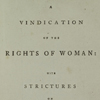Prologue: First of a New Genus—Mary Wollstonecraft
![[Mary Wollstonecraft]](images/sqthumb/ps_cps_cd6_081.jpg) [Mary Wollstonecraft]
[Mary Wollstonecraft]
NYPL, Pforzheimer
Collection
Mary Wollstonecraft's brief lifetime (1759–1797)
encompasses all the major themes of this exhibition. A brilliant,
adventurous, compassionate woman, she embodied a new sense of
what was possible for her sex. As a girl, she tried to defend
her mother against the drunken violence of her father. Later,
she became a governess, founded her own school, and slowly transformed
herself into a versatile professional journalist. The height of
fame came with her 1792 masterpiece,
A Vindication of the
Rights of Woman, in which she demanded that women take responsibility
for themselves, and reform the world by reforming their own lives.
 A Vindication
of the
A Vindication
of the
Rights of
Woman…
NYPL, Pforzheimer
Collection
Alone, she traveled to Ireland, Portugal, France, and Scandinavia.
In France she witnessed the Revolution's progress, wrote
its history, took an American lover, Gilbert Imlay, and became
a mother. Abandoned by Imlay, Wollstonecraft returned to London
and attempted suicide—twice—but lived to meet her
great love, the philosopher William Godwin. She died in September
1797 soon after giving birth to their daughter, leaving an
unfinished novel called
The Wrongs of Woman. That daughter,
Mary Wollstonecraft
Godwin Shelley, grew up to write
Frankenstein, a novel imagining
the wrongs of science and the rights of monsters. Wollstonecraft,
above all a persevering explorer of the human condition, would
have been proud of her daughter's work.

![[Mary Wollstonecraft]](images/sqthumb/ps_cps_cd6_081.jpg)
